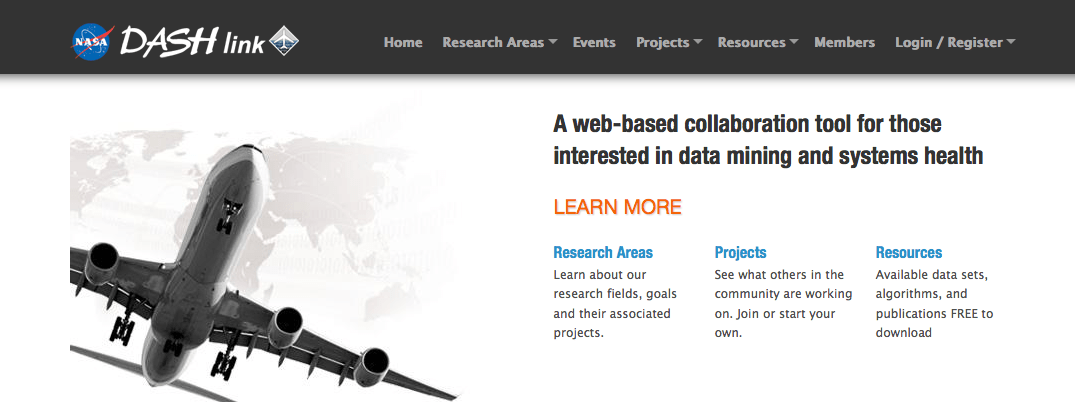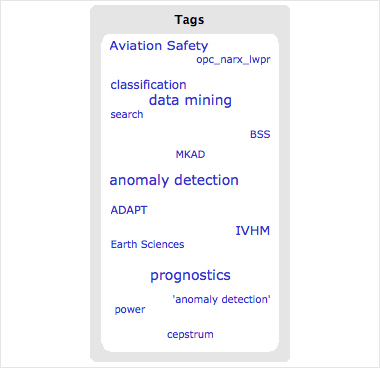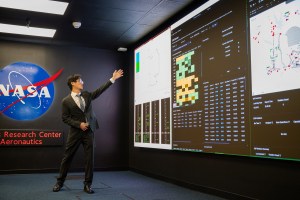NASA researchers have created an online resource that dramatically changed how the agency fosters collaborative research. In this new innovative method capitalizing strengths of the Internet, scientists can share information about systems health and data mining while aiming to help improve aviation safety in ways never before possible.
The web site is called Dashlink. DASH stands for Discovery in Aeronautics Systems Health. The name hints at the identity of the particular group of scientists who created this online gathering place in 2008. The site has more than 410 registered users.
“The primary goal of Dashlink is to disseminate information on the latest data mining and systems health algorithms, data and research,” said Ashok Srivastava, principal investigator for NASA’s Integrated Vehicle Health Management Project at the agency’s Ames Research Center in California.
Integrated vehicle health management, or IVHM, involves technologies designed to monitor all the different systems that enable an aircraft to fly. IVHM technologies are sensors and software applications that work in concert to detect and address potential problems with an aircraft before the problems become serious.
To be effective, IVHM requires new software programs that can record and analyze instantly many variables such as temperature, pressures, stresses, and even cockpit switch positions.
Also needed are new computer algorithms, which are sets of mathematical rules used by the computers to make decisions on how to solve a problem given a certain set of data.
Dashlink allows researchers, whether inside or outside NASA, who are working on a particular software application to share the applications they have written, test each other’s work, and openly discuss the results.
“It’s totally different from how other projects are run,” Srivastava said, noting that the usual form of communication among scientists is published papers, which can take months to distribute and offer no immediate interaction with the author.
Interaction is important because a staple of scientific research is the ability of one group of scientists to duplicate the work of another group and achieve the same results. In the data mining field, duplicating results can be difficult and infrequent.
“We realized that the best way to validate our work was to put it out there for others to review, check our work and see what’s going on. Now we have a community of researchers across the country working together and interacting with each other,” Srivastava said.
Dashlink is available to anyone with an interest in integrated vehicle health management software and sensor applications. Those outside NASA can join if a NASA civil servant sponsors the registration. That is what Suratna Budalakoti did when he joined the site in September 2008.
Then a student at the University of California Santa Cruz, he collaborated with Srivastava and others in writing a data mining algorithm called Sequence Miner and used Dashlink to communicate remotely with other researchers – something he continues to do today.
“Dashlink enables open and quick exchange of ideas, data and software. It makes the process of knowledge sharing convenient and fast,” Budalakoti said.
As of July 2010, Dashlink had 16 algorithms posted to it, as well as 10 different datasets available for study.
In posting these programs and datasets in a public environment, all of NASA’s policies and procedures related to privacy protection, proprietary rights and the transfer of technology are being followed to the letter, Srivastava said.
“If a user wants to put up something they have to certify they’ve followed the instructions for posting. Users also can flag inappropriate content, but we’ve never had that problem,” Srivastava said. “We’re very happy with the size of the community.”
And now the online research community is set to expand.
Researchers from other NASA organizations such as the Earth Sciences Division are eyeing Dashlink’s features. The Earth Sciences Division is planning its own Web site to facilitate the same sort of peer-to-peer interaction, said Elizabeth Foughty, the current Dashlink team lead.
In fact, the programmers behind Dashlink and the new Web site already are collaborating to create a single computer platform from which both sites can operate sharing the same code and functionality.
With the introduction of the new cross-discipline collaboration platform expected “sometime soon,” Foughty said, Dashlink will get a facelift and have additional interactive features enabled. The new platform will allow other NASA science disciplines to create and roll out quickly their own collaborative Web sites.
“Our hope is that this new capability for researchers to access NASA resources and collaborate with each other will hasten and spur the kind of innovation needed to solve our future challenges in aviation and space,” Foughty said.




































